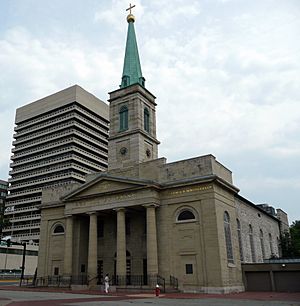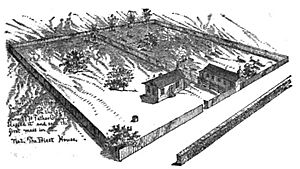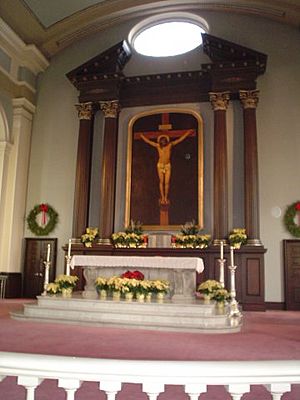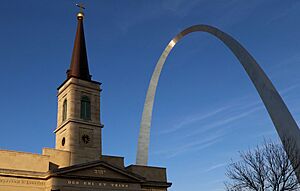Basilica of St. Louis, King of France facts for kids
Quick facts for kids Basilica of Saint Louis, King of France |
|
|---|---|

Basilica in June 2011
|
|
| Religion | |
| Affiliation | Roman Catholic |
| Ecclesiastical or organizational status | Minor basilica |
| Location | |
| Location | 209 Walnut Street, St. Louis, Missouri, United States |
| Architecture | |
| Architect(s) | Joseph Laveille and George Morton |
| Architectural style | Greek Revival |
| Groundbreaking | 1770 (first church) 1831 (current church) |
| Completed | 1834 |
| Specifications | |
| Direction of façade | South by west |
| Length | 134 feet (41 m) |
| Width | 84 feet (26 m) |
| Height (max) | 95 feet (29 m) |
| Materials | Limestone |
| Website | |
| Basilica of St. Louis, King of France | |
The Basilica of Saint Louis, King of France is a historic Catholic church in St. Louis, Missouri. People often call it the Old Cathedral. It was the very first cathedral built west of the Mississippi River. For many years, until 1844, it was the only parish church in St. Louis.
This church is one of two Catholic basilicas in St. Louis. Both are named after King Louis IX of France, who is also the namesake of the city itself. The building you see today was built between 1831 and 1834. It stands close to the historic riverfront in St. Louis.
The church is surrounded by Gateway Arch National Park. However, the church itself is not part of the park. It was kept safe and sound when all the buildings around it were taken down. This was done to make space for the famous Gateway Arch and its park. Today, Reverend Nicholas Smith serves as the Rector of the Basilica.
The Basilica is a special kind of church called a "personal parish." This means it serves specific groups of people rather than everyone in a certain area. It is a very popular place for weddings in the St. Louis area. It also attracts many tourists because of its history and its location near the iconic Gateway Arch.
Contents
History of the Old Cathedral
Early Church Buildings in St. Louis
When Pierre Laclède and Auguste Chouteau founded the city of St. Louis, they set aside land for a Catholic church. The first Catholic records show that a traveling priest used a tent for services in 1766. By 1770, a small log house was built on the site. This building was blessed by Reverend Pierre Gibault on June 24, 1770. It was made bigger in 1776 to include a log church. Even with a more solid building, no priest lived permanently in St. Louis until 1811.
These early log buildings started to be replaced in 1818. Bishop Louis William Valentine Dubourg ordered a new brick church to be built. Gabriel Paul designed this brick structure. During Bishop Dubourg's time, many important items were given to the church. These included old artifacts, paintings, and an organ.
While the brick church was being built, a cemetery was started nearby. Many of the people who helped found St. Louis were buried there. The current church was built on the land where this first cemetery was located. The people buried in the original cemetery were later moved. Some went to a "Second Catholic cemetery," and others were reburied under the new church. No new burials happened at the original cemetery after 1828. Those moved to the Second Catholic Cemetery were later moved again to Calvary Cemetery after 1854. The current church was finished and dedicated in 1834.
Bishop Dubourg also helped start St. Louis Academy in 1818. This school later became Saint Louis University. It was in a two-story brick building next to the new church. The brick church was fully completed in 1821.
Building the Current Basilica
In 1826, St. Louis was growing quickly. Because of this, the Diocese of St. Louis was created. The first bishop of this new diocese was Joseph Rosati. He decided to build a new, larger cathedral. This new church is what we now know as the Basilica of St. Louis, King of France. Bishop Rosati laid the first stone of the church on August 1, 1831.
The church was designed and built by Laveille and Morton. This was one of the first architectural companies west of the Mississippi River, north of New Orleans. The construction was finished by late 1834. On Sunday, October 26, 1834, the cathedral was officially blessed. There was a big ceremony with the local military and many church members.
After the Diocese of St. Louis became an archdiocese in 1847, the cathedral became home to an early group of the Society of Saint Vincent de Paul. This is a Catholic charity that helps people in need. Archbishop Peter Richard Kenrick and St. Louis Mayor Bryan Mullanphy were among the people who started this group. At first, they helped immigrants coming from Ireland and Germany. Later, they helped all residents of St. Louis.
The tradition of helping the poor continued into the early 1900s. Reverend John Tannrath took charge of the church on September 5, 1915. He not only fixed up the church and its living quarters but also reopened a school for local immigrant children. He also arranged care for children and adults with disabilities.
Recent Times for the Basilica
Because St. Louis kept growing, a much larger church was built and blessed in 1914. This new church was farther west, in the city's Central West End neighborhood. This larger church, the Cathedral Basilica of Saint Louis, is still the main church for the archbishop of St. Louis.
To honor the importance of the original cathedral, Pope John XXIII gave it a special title on January 27, 1961. He called it a basilica. This is how it got its current name, the Basilica of Saint Louis, King of France. Soon after, in 1963, the church was updated by a well-known St. Louis architectural company, Murphy and Mackey.
In 2015, the Basilica went through a big restoration project. This included many improvements:
- The outside limestone and sandstone were repaired.
- The windows were replaced with new, energy-efficient glass. These new windows still looked like the original Gothic design.
- The steeple, roofs, and gutters were fixed.
- The front doors were restored.
- The parking lot, entrance paths, and landscaping were improved.
- The inside entrance area was renovated.
- All the carpet was removed, and the wood floors underneath were repaired.
- The decorative woodwork and statues were restored.
Today, the church serves local members who are "few in number but strong in loyalty." It also serves people who work nearby and many tourists. Because of its beautiful location by the Mississippi River and near the Gateway Arch, it is a very popular place for weddings. It ranks second in the number of Catholic weddings in the archdiocese, just behind St. Francis Xavier College Church at Saint Louis University.
Design and Special Items
The church is built in the Greek Revival style. It is known for its beautiful marble altars. It also has a painting of Saint Louis honoring the Crown of Thorns. This painting was a gift from Louis XVIII, who was the King of France. Another special item is an exact copy of the painting Crucifixion by Diego Velázquez. This copy was placed in the church in the second half of the 1900s.
Above the main entrance to the church, words are carved in gold. They say In honorem s. Ludovici. Deo uni et trino dicatum. A. MDCCCXXXIV. This means "In honor of St. Louis. Dedicated to the one and triune God. A.D. 1834." There are also Hebrew letters above this carving. They are meant to spell out the Tetragrammaton, which is a holy name for God. Some people thought there was a mistake in the letters, but they actually appear to be correct.
The church basement holds many items connected to the history of the Roman Catholic Archdiocese of Saint Louis. One of these is a bell given to the church by the governor of the Louisiana territory in the early 1800s. Bishop Joseph Rosati, who ordered the church to be built, is buried in a special vault under the main altar area.
See also
 In Spanish: Basílica de San Luis Rey de Francia (San Luis) para niños
In Spanish: Basílica de San Luis Rey de Francia (San Luis) para niños
- List of churches in the Roman Catholic Archdiocese of St. Louis
- List of Catholic cathedrals in the United States
- List of cathedrals in the United States





